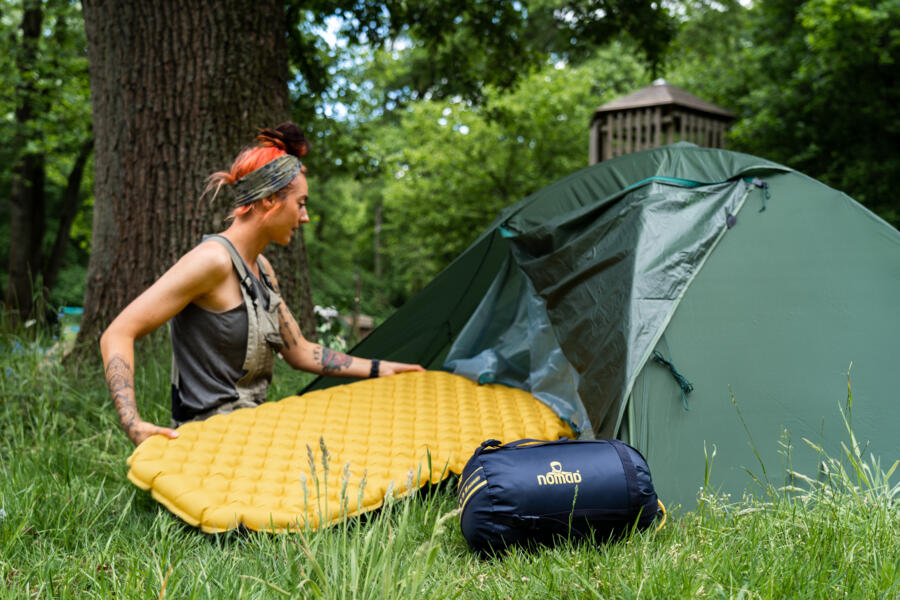
Freedom of nature
Sustainable getaways
Real human connections
How to choose the best hiking gear
Going on a trek? Then good hiking gear is probably the most important thing to prepare. In this blog you can read exactly what you need to build the ultimate set of hiking equipment.
Going on a trek? Then good hiking gear is probably the most important thing to prepare. In this blog you can read exactly what you need to build the ultimate set of hiking equipment.
My name is Rick and I write blogs on hiking and other topics for Campspace. I’ve travelled in a campervan for two years and in the meantime started an outdoor company through which I show people how to experience the fun, adventure and other benefits of hiking. In this blog, I’ll tell you everything you need to know about hiking gear: from a good pair of hiking trousers to which tent to take along for a multi-day hike. The following items will be covered:
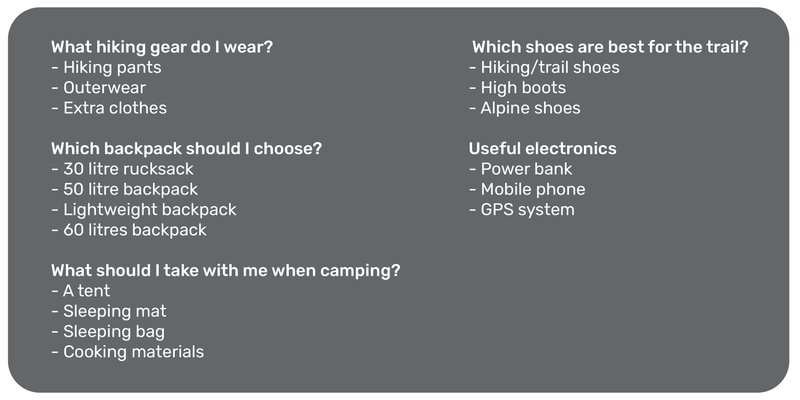
What hiking clothes should I wear?
There are no set rules for clothing when it comes to hiking gear. You should wear something that feels comfortable for you. However, there are a few things you can pay attention to. When you are expecting large differences in temperature, it is advisable to wear layers. It is also important to protect yourself from the sun when hiking, for example with UV-resistant clothing and sun block.
Hiking trousers
It's actually very simple when it comes to hiking shorts. Make sure the trousers in your hiking gear are comfortable and fit well. If it's high summer and warm, you can easily wear shorts. However, you should bear in mind that shorts offer less protection against insects and bushes. A pair of zip-off trousers is also an option if you are planning to hike for several days. This way you can wear long trousers in the morning, but when it gets warmer you can easily unzip them.
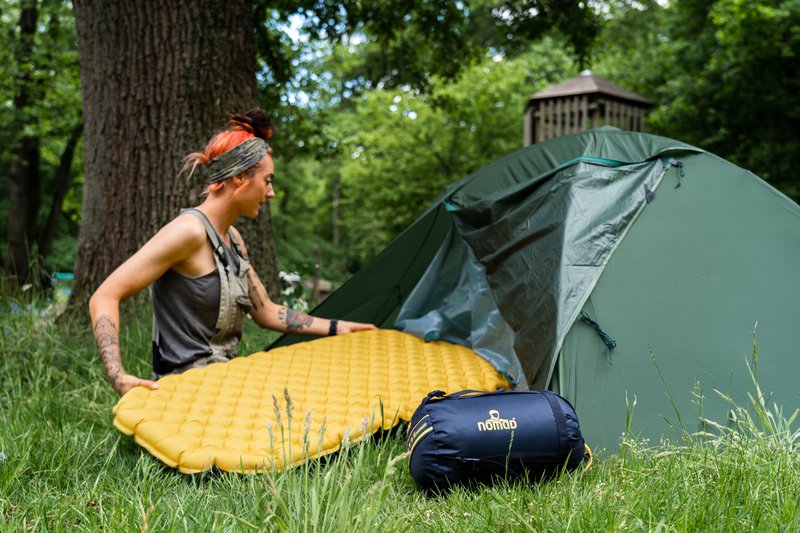
Outerwear
In the mountains and on trails, you will want to wear layers. This is because you are dealing with huge temperature differences. You may need 3 layers with a down jacket in the morning and just a t-shirt in the afternoon. I advise you to choose a shirt with long sleeves (I also use my merino thermo shirt for this), this saves you from applying sun cream. Make sure you do not use cotton for this. Then a fleece or synthetic lightweight cardigan or sweater, and a down jacket on top. You can then choose an extra rain jacket if there is a chance of bad weather.
I only take two sets of clothes in my hiking gear. One is my hiking outfit and the other is an outfit for when I go to rest. For example, in a mountain hut or in the tent. Personally, I do not take separate pyjamas. I use my thermal clothing for this if it is cold.
Extra clothing
I always take two pairs of socks with me when I am hiking for several days. If your feet get wet you can always put on a dry pair. I also always wear a buff, which is a kind of thin scarf. An advantage is that my buff also protects against UV rays. As a last extra piece of clothing, I often wear a hat, but you can also choose a cap. Again, try to minimise the amount of hiking gear you bring - don’t overpack.
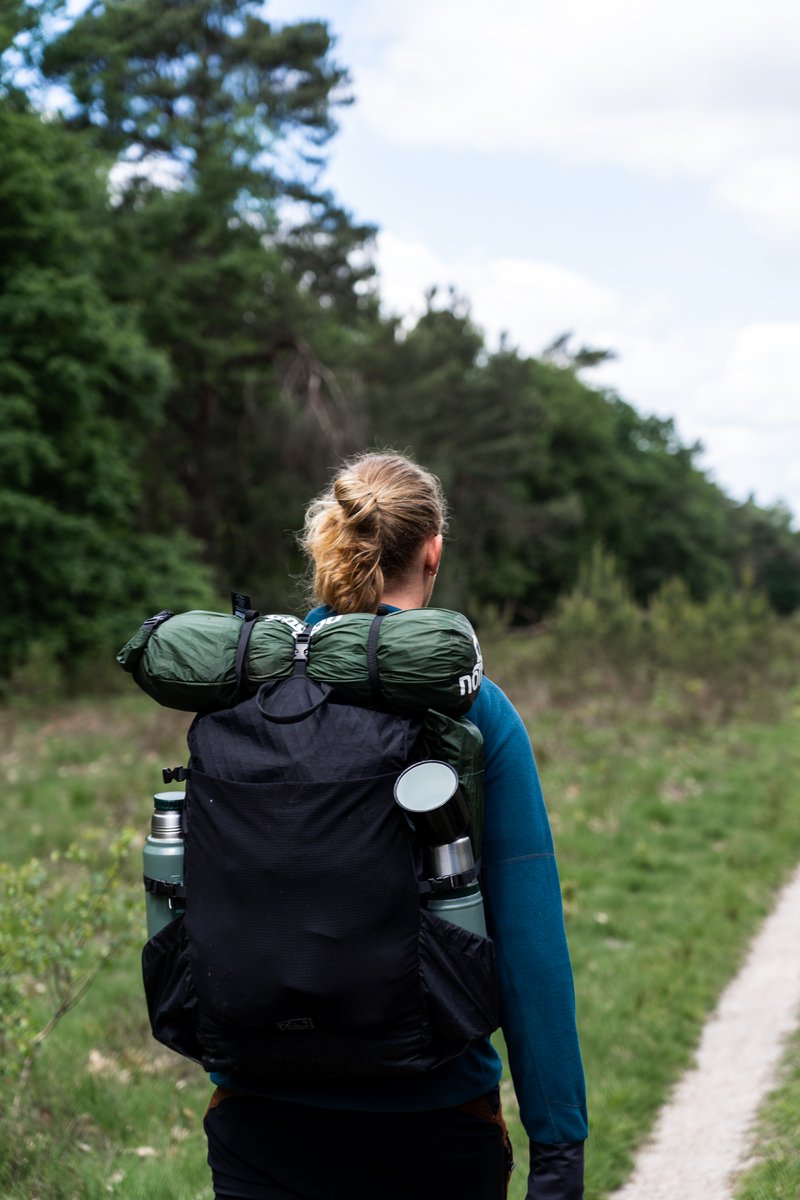
Which backpack do I choose?
A backpack is an essential part of your hiking gear. When choosing a backpack, there are three things to consider: Will you be camping? Will you be sleeping in accommodation? What is the purpose of your hike? If you are camping, your backpack will automatically be bigger. You want to take a backpack that is big enough for a tent and sleeping materials. In case of an accommodation, it can all be a bit more compact. You only need clothes and maybe some comfort and entertainment. The purpose also determines the type of backpack you need. How long will you be travelling for? Are you going to cover a lot of kilometres or will you only move around a little? We have put together a list of hiking gear backpacks:
Lightweight backpack
If you have ultra-light luggage, but you are going camping, you can choose a lightweight backpack. This is a backpack that is made of light material and is very minimalistic. I have already written a blog about this backpack on my website. If you read Dutch, check it out!
+/- 30 litre backpack
A 30 litre bag is often seen as the perfect backpack for a hut trip or a trip where you sleep and eat at accommodations. You can put an extra set of clothes in it and you can take some stuff for entertainment at the accommodation. You will still have enough space left for food and drinks.
+/- 50 litre backpack
This size of backpack is usually a good fit for a trekking trip. It is big enough for all your sleeping materials, a one-person tent and your food for the road. In this case you should not have too heavy stuff, but lightweight camping equipment.
+60 litre backpack
I do not recommend carrying a bigger backpack than 60 litres, although most people buy this. Often you will take stuff just to fill your backpack, while this is not necessary at all. If your goal is to set up a nice camp in the wilderness, for which you need more equipment, a backpack of more than 60 litres can be nice.
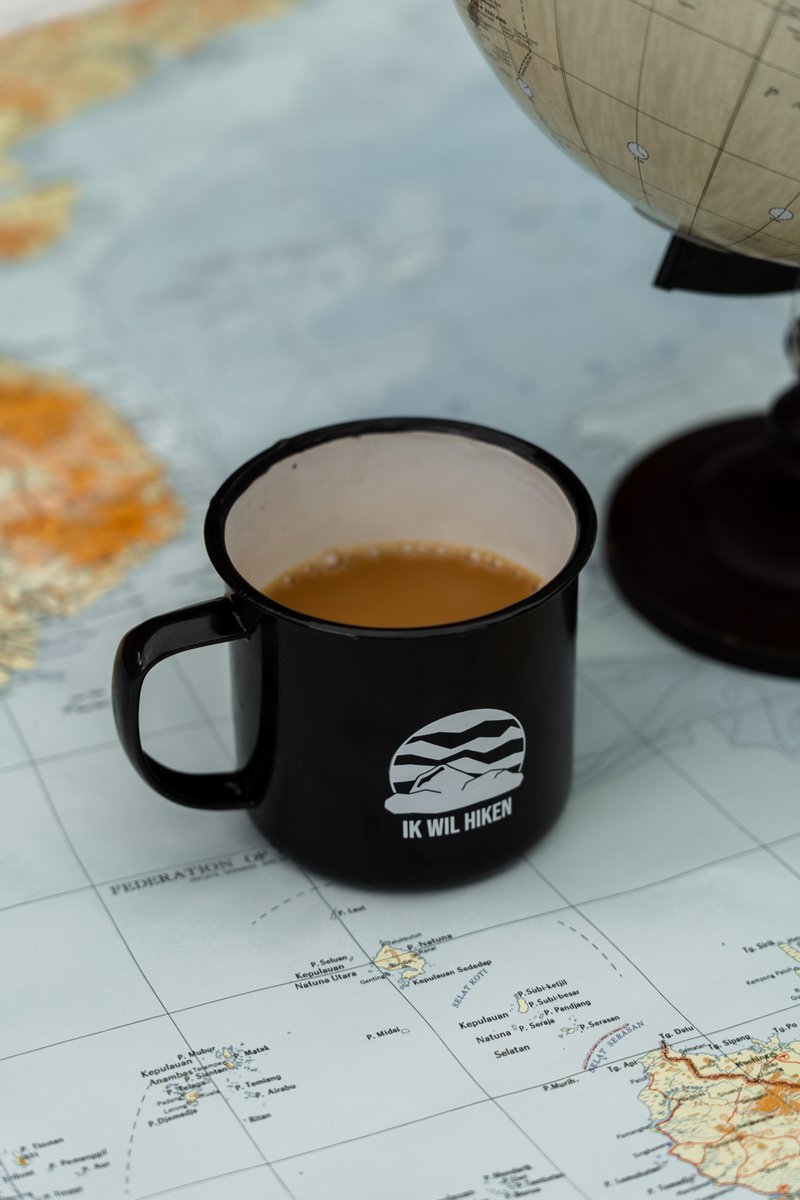
In the end, the most important thing is that the bag is comfortable and fits your body size and weight. You can imagine that someone who is small and narrow in stature needs a completely different fit than someone who is tall and broad in build. A 65+ litre bag will be harder to carry for someone who is 1.55 metres tall and 50 kilos, than for someone who is taller and weighs more. The bag will be too long, too wide and above all too heavy to carry realistically for a long distance in a comfortable way. It is not impossible to find, but in any case more difficult to find such a large bag for a smaller back. Of course, this is person-specific and there are no hard lines to be drawn, but it is good to remain realistic.
In shops, you will find models that are specific to men and women, and you may also find different sizes of the same bag. This has to do with back length and width. Fortunately, back length can be adjusted in many bags, but width is less often the case. When a bag is too narrow or too wide, it leans on your shoulders in an uncomfortable position and cannot distribute the weight of the bag properly. So make sure you try on a bag and try it out in the shop. Sometimes they have weight bags to help you with this. This will ensure that you start your hike in the most comfortable way possible, as a bag is one of the most important parts of your hiking equipment.
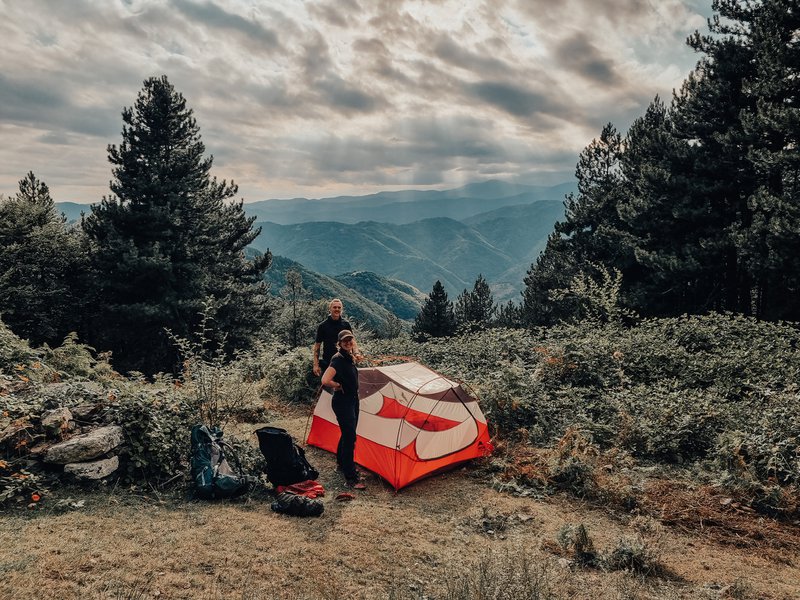
What should be part of my hiking gear when I go camping?
Are you planning to go camping? This is different to sleeping in a hut. When you go camping you have to think about your camping equipment as part of your hiking gear. I have listed for you the extra equipment you will need when you go camping.
Tent
A lightweight tent is the way to go when you are going to make a multi-day trip. There are many different tents to choose from. For example, you have the MSR Hubba Hubba NX which is very popular among hikers for its light weight, easy set up and compact volume. You can also choose a Z-packs tent, which is even lighter. Try to keep your tent under three kilos when trekking.
Sleeping pad
When it comes to sleeping mats, there are different types and sizes. Not everyone sleeps equally well, so some go for more comfort and others for less weight. The pack size or volume of a sleeping mat can also vary greatly. If you are travelling in the winter, you should pay attention to the R-value. This is how well the sleeping mat insulates when you lie on it. You don't want to lie on a cold surface, so a higher R-value is important in winter. Air mats are often lighter than foam mats, but these often require a separate pump or pump bag and have a lower insulation value. Air mats can be more easily kept small in size, while still being thick and comfortable, but they are often also more vulnerable. You must therefore pay more attention to the surface on which you place your mat. I use the Therm-a-rest NeoAir X-lite for many of my hikes. Super light and small to take with you!
Sleeping bag
Choosing a good sleeping bag is essential for a comfortable hike. When choosing a sleeping bag, it's important to choose the right comfort temperature. A woman needs a temperature 5 degrees higher than a man, so you should take this into account. You can choose a mummy sleeping bag or a quilt sleeping bag. Mummy sleeping bags tend to stay warmer and are smaller in size, but for people who turn in their sleep, a more square model may be more comfortable. There are different materials to choose from, such as down, synthetic and sometimes cotton. It is not just a question of what you feel comfortable with, because these materials also have very different properties. Down retains warmth better and for longer, and breathes well. Synthetic is often a lot cheaper, but doesn't retain the heat as well and doesn't breathe as well. Cotton is the most airy and feels pleasant on the skin, but is also heavier in weight, larger in pack size and not very suitable for cold temperatures.
Cooking materials
I always take my Jetboil with me when I go on a multi-day hike. A Jetboil works on a small gas tank and can bring water to a boil in a short time. It is also a very compact and lightweight system that you can easily carry in your backpack. There is also a variant of Primus that is very similar to the Jetboil. I also recommend light food such as dry food because it is a lot less heavy. This is ideal in combination with a burner like the Jetboil.

Hiking gear: shoes
If the shoe fits, wear it. But not every trail is the same, so sometimes you'll have to look for a shoe that fits the ground. High up in the Alps, you will need different shoes than when you are hiking in the Netherlands. In order to indicate the difference between shoes, categories have been devised. I myself do not fully believe in these categories and therefore I always talk about 3 different types: walking/trail, high mountain and alpine.
1) Hiking/trail shoes
During a walk on flat terrain in the Netherlands, you do not necessarily need a high walking shoe. The terrain will often be well paved and you will rarely sprain your foot. A low walking shoe or a trailrunner is in my opinion fine for a normal walking path. This is not always recommended in shops, because the soles of trail runners wear down much faster on asphalt. So keep this in mind a bit.
2) High mountain shoes
What if you want to run in high mountains? This is where high mountain shoes (B-category or C-category) come in. These are ankle-high shoes which means that there are fewer stones in your shoes and you have more support for your ankles. If you run often and have strong ankles, then in my opinion you can also choose a trailrunning shoe for this terrain. The B and C category shoes have progressively stiffer soles, so you will feel less bumps and rocky ground through the sole. For most people, a stiffer, sturdy sole means your feet will tire less on rough ground.
3) Alpine shoes
These are shoes you may never have seen before. The sole of these shoes is almost unbreakable and unbendable. These shoes are used high up in the mountains on glaciers. These shoes are made for walking and certainly not for hiking. The stiff sole does not allow your foot to unroll, which means that your knees and feet will hurt when you walk on normal surfaces. Only if you are going to make an expedition at altitude will you have to think about an alpine shoe.
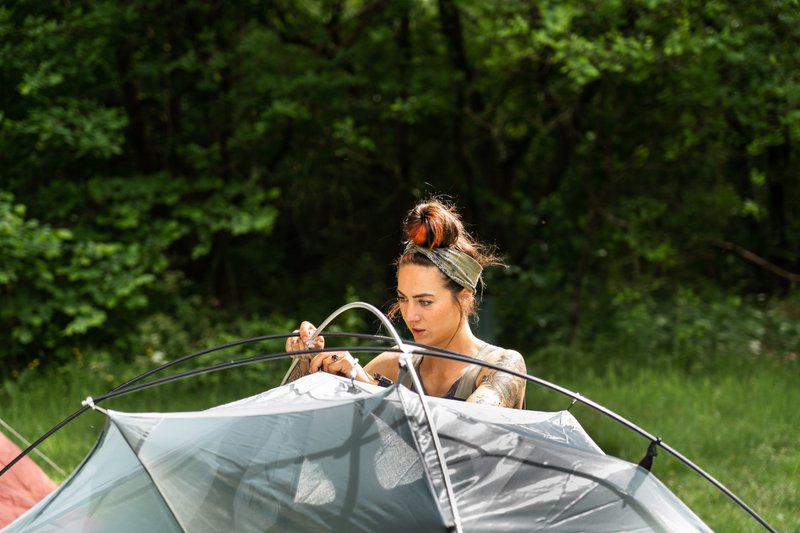
Hiking gear: electronics
I always try to relax during a hike and spend a little less time on my phone by enjoying nature offline. Still, we all want to let the folks back home know how it's going from time to time, and you obviously need to be able to navigate, so a GPS is important in your hiking gear.
Powerbank
A powerbank is pretty essential when you go on a multi-day hike. For example, if you are hiking in the wilds of Sweden, chances are slim that you will find a café where you can charge your phone. Depending on how many days you will be without power, you can choose a larger or smaller powerbank. I have a powerbank of +10.000 Mah, with this I can charge my phone about 4 times.
Mobile phone
Well, we live in a time where we can't really do without our phones and although I plead for less phone use on the trail, I am also guilty of taking the phone along in my hiking gear. It's nice to take the occasional photo when you're back at a beautiful campsite. And don't forget to pack a cable to charge it. It is annoying when you have the powerbank with you, but no cable!
GPS
Where you can navigate using your phone, you can also choose to use a GPS system. This is a navigation system that has better reception than the average telephone. This is why you often see a GPS-system such as a Garmin being used on trails such as the Pacific Crest Trail. This allows you to send text messages via satellite connection even in remote areas.
More about hiking and hiking gear
If you want to go on a hike, you should think carefully about what you’re going to take with you. For example, when I started hiking I took a lot of books with me and I packed far too much. The search for the ultimate hiking equipment was a process that I enjoyed immensely. Looking back now, I have made mistakes, but there is no shine without friction. Want to know more about hiking? Then take a look atwww.ikwilhiken.nl or follow me on instagram: @ik.wil.hiken
Find your sustainable getaway
Up to 95% CO2 reduction if you book a campspace adventure. Learn more